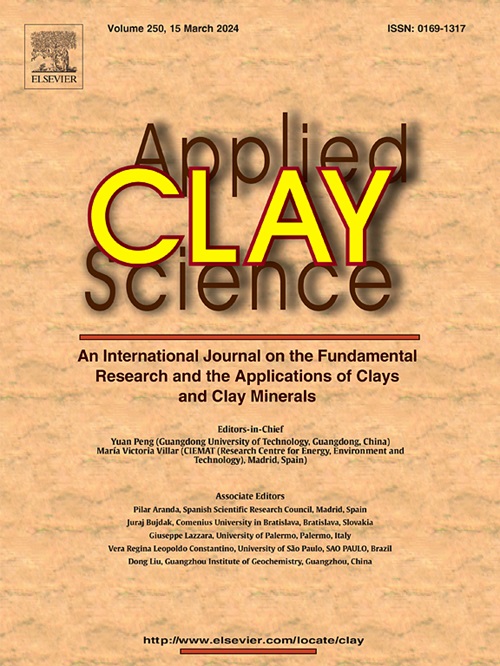由滑石或高岭石层状颗粒稳定的水包水酸洗乳剂
IF 5.8
2区 地球科学
Q2 CHEMISTRY, PHYSICAL
引用次数: 0
摘要
高岭石(Kaol) - Al2Si2O5(OH)4和滑石- Mg3Si4O10(OH)2 (talc)是丰富的粘土矿物,具有纳米级厚度和微米级长度的层状颗粒。当考虑低界面张力乳剂(如水包水乳剂)的稳定性时,这些特征是有趣的属性。在这里,用几种仪器技术对高岭土和滑石层状颗粒进行了表征。然后,我们评估了添加高岭土和滑石粉对支链淀粉(AMP)和木葡聚糖(XG)聚合物的水溶胶分散形成的水包水乳液的影响。从宏观和液滴大小分布的角度对乳剂进行了评价。测定了空气中水滴在高岭土和滑石压球上的视接触角(ACA)。由于滑石粉的液滴尺寸(D50 = 2.01±0.20 μm)大于kol (D50 = 0.34±0.02 μm),因此滑石粉颗粒无法在液滴表面形成完全覆盖。制备24 h后,液滴也被更快地拉下,聚结增加,平均液滴尺寸增大。在这两种情况下,固体相和水相之间的密度差异导致颗粒沉降,即使被吸附到液滴的界面上,也会在烧瓶底部产生浓缩的乳液。虽然滑石颗粒在72 h后完全沉积,但kol颗粒仍留在液滴界面,形成了稳定性增强的皮克林乳液。本文章由计算机程序翻译,如有差异,请以英文原文为准。
Water-in-water pickering emulsions stabilized by talc or kaolinite layered particles
Kaolinite (Kaol) - Al2Si2O5(OH)4 and talc - Mg3Si4O10(OH)2 (Talc) are abundant clay minerals, with layered particles characterized by nanometric thicknesses and few micrometers in length. Such characteristics are interesting attributes when considering the stabilization of emulsions with low interfacial tension, like in water-in-water emulsions. Here, Kaol and Talc layered particles were characterized by several instrumental techniques. Then, we evaluated the effect of Kaol and Talc addition on water-in-water emulsions, formed by aqueous colloidal dispersions of amylopectin (AMP) and xyloglucan (XG) polymers. The emulsions were evaluated macroscopically and by means of droplet size distributions. The apparent contact angle (ACA) of a water droplet in atmospheric air was also measured on Kaol and Talc pressed pellets. Due to a larger droplet size (D50 = 2.01 ± 0.20 μm) when compared to Kaol (D50 = 0.34 ± 0.02 μm), Talc particles did not create complete coverage on the droplet surfaces. The droplets were also dragged down faster, increasing coalescence and the average droplet size after 24 h of preparation. In both cases, the difference in densities between the solids and the aqueous phases led to particle sedimentation, even when adsorbed to the interface of the droplets, generating a concentrated emulsion at the bottom of the flasks. While talc particles sedimented completely after 72 h, Kaol ones remained at the droplets interface, creating Pickering emulsions with enhanced stability.
求助全文
通过发布文献求助,成功后即可免费获取论文全文。
去求助
来源期刊

Applied Clay Science
地学-矿物学
CiteScore
10.30
自引率
10.70%
发文量
289
审稿时长
39 days
期刊介绍:
Applied Clay Science aims to be an international journal attracting high quality scientific papers on clays and clay minerals, including research papers, reviews, and technical notes. The journal covers typical subjects of Fundamental and Applied Clay Science such as:
• Synthesis and purification
• Structural, crystallographic and mineralogical properties of clays and clay minerals
• Thermal properties of clays and clay minerals
• Physico-chemical properties including i) surface and interface properties; ii) thermodynamic properties; iii) mechanical properties
• Interaction with water, with polar and apolar molecules
• Colloidal properties and rheology
• Adsorption, Intercalation, Ionic exchange
• Genesis and deposits of clay minerals
• Geology and geochemistry of clays
• Modification of clays and clay minerals properties by thermal and physical treatments
• Modification by chemical treatments with organic and inorganic molecules(organoclays, pillared clays)
• Modification by biological microorganisms. etc...
 求助内容:
求助内容: 应助结果提醒方式:
应助结果提醒方式:


